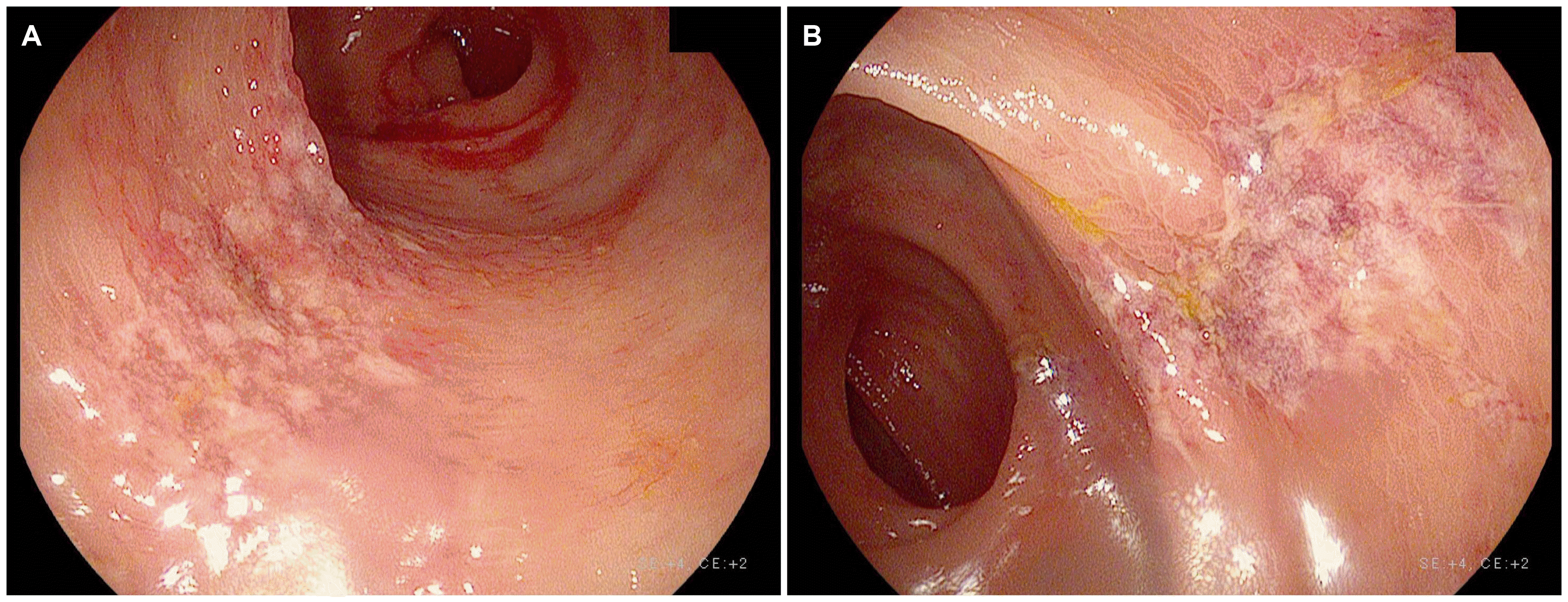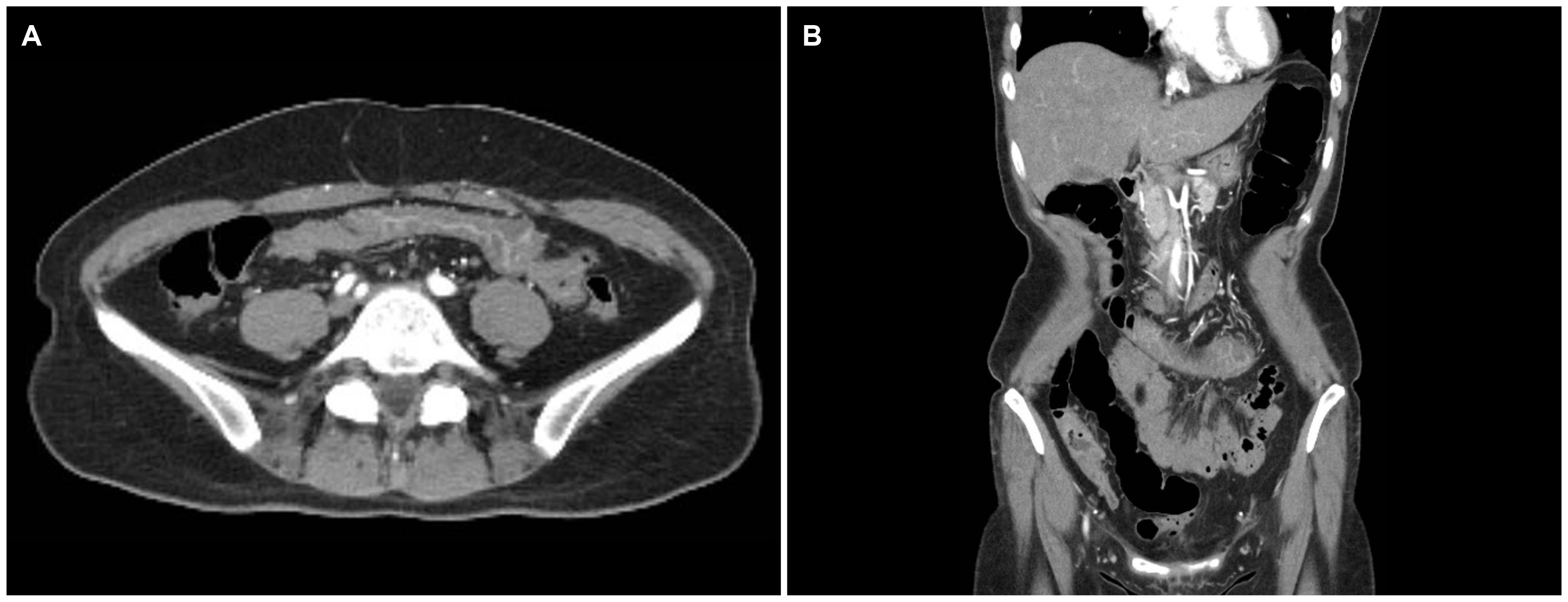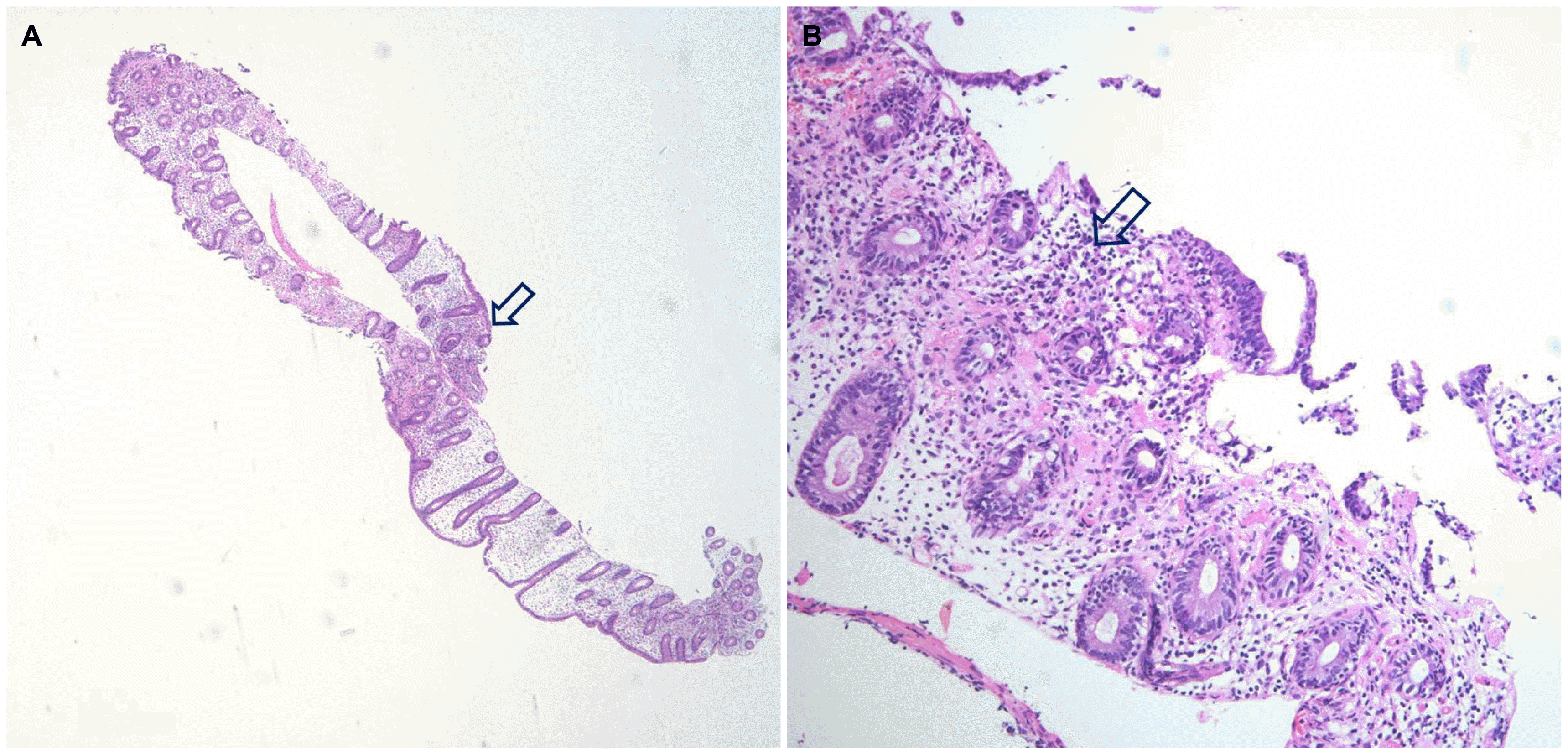This article has been
cited by other articles in ScienceCentral.
Abstract
Ischemic colitis resulting from bowel preparation for colonoscopy is extremely rare, with only a small number of cases with polyethylene glycol having been reported. Here, we present a patient with ischemic colitis after administration of a low-volume oral sulfate solution (OSS). A 49-year-old female without any significant medical history experienced abdominal pain, vomiting, and hematochezia after ingestion of OSS. She complained of severe abdominal pain during colonoscopy, and diffuse edema, hyperemia, friability, and shallow erosions were present on the transverse, descending, and sigmoid colons. A mucosal biopsy revealed mixed lymphoid inflammatory cell infiltration with de-epithelialization, whereas an abdominal CT scan showed submucosal edema on the transverse colon. A diagnosis of ischemic colitis was made. The patient recovered with fluid and antibiotic therapy without significant sequelae. Although OSS is a clinically validated and generally safe bowel preparation agent, ischemic colitis is a rare complication that should be considered.
Go to :

Keywords: Colitis, ischemic, Bowel preparation, Colonoscopy
INTRODUCTION
Ischemic colitis is caused by impaired blood perfusion to the intestine.
1 It frequently affects the elderly with various clinical courses, from self-limited ischemia to life-threatening infarction and necrosis.
2 Nonspecific symptoms such as abdominal pain, diarrhea, and hematochezia are frequently present, whereas mesenteric artery embolism or thrombosis, trauma, congestive heart failure, excessive physical activity, shock, and mechanical obstruction are well-known risk factors for this condition.
3 Ischemic colitis resulting from bowel preparation for colonoscopy is extremely rare, with only a few cases due to administering polyethylene glycol (PEG) and bisacodyl having been reported worldwide.
4 Herein, we report a rare case of ischemic colitis caused by low-volume oral sulfate solution (OSS) for bowel preparation.
Go to :

CASE REPORT
A 49-year-old female without significant medical history attended the outpatient clinic of the gastroenterology department with severe abdominal pain, which started after ingestion of OSS for bowel preparation and became aggravated during colonoscopy. She had the colonoscopy as scheduled as part of an elective general health checkup. Upon physical examination, the abdomen was soft to palpation with moderate tenderness of the lower part. Before this episode, she had received colonoscopies several times without complications. She did not have any symptoms before starting the bowel preparation. The patient experienced abdominal pain, vomiting, and hematochezia shortly after ingesting a low-volume OSS (magnesium sulfate anhydrous 1.6 g, sodium sulfate anhydrous 17.5 g, potassium sulfate 3.13 g, in 177 mL of Suclear Solution
®; Pharmbio, Seoul, Korea) with water as instructed. During the colonoscopy, she experienced further severe abdominal pain from the beginning of the procedure onward. Diffuse edematous hyperemic inflammation of the mucosa as well as shallow erosions and friability in the transverse, descending, and sigmoid colons were evident during the colonoscopy (
Fig. 1). At the time of admission, her vital signs were blood pressure, 130/70 mmHg; heart rate, 82 beats/min; respiratory rate, 20 breaths/min; and body temperature, 37.0℃. The initial laboratory findings were white blood cell count, 11,000/μL (72.9% neutrophils); hemoglobin, 15.2 g/dL; hematocrit 45.1%; platelets 324,000/μL; CRP, 0.523 mg/dL; BUN, 15.9 mg/dL; and creatinine, 0.94 mg/dL. An abdominal CT scan with enhancement was carried out after admission to investigate the cause of the abdominal pain, and CT images showed submucosal edema of the transverse colon (
Fig. 2). Multiple biopsies of the transverse and sigmoid colon revealed mixed lymphoid inflammatory cell infiltration with de-epithelialization, thereby suggesting ischemic colitis (
Fig. 3). Treatment with dextrose saline hydration and intravenous antibiotics (ceftriaxone and metronidazole) was performed. Her symptoms gradually improved with therapy, and she was discharged without serious complications. In the follow-up outpatient visit, it was found that she had recovered completely without sequelae.
 | Fig. 1Colonoscopy revealed diffuse edematous hyperemic inflammation, shallow erosions, and friability in mucosa of (A) sigmoid and (B) transverse colons. 
|
 | Fig. 2Abdominal computed tomography revealed submucosal edema of transverse colon (A) transverse section and (B) coronal section. 
|
 | Fig. 3(A, B) Histologic examination of sigmoid and transverse colonic mucosa showed mixed lymphoplastic cell infiltration (arrows) and de-epithelialization, consistent with ischemic colitis (A: H&E, ×40; B: H&E, ×200). 
|
Go to :

DISCUSSION
Ischemic colitis has various etiological and clinical presentations. Cases rarely present without risk factors such as old age, diabetes, dyslipidemia, heart failure, and/or peripheral arterial disease, whereas medications reported to be associated with ischemic colitis include vasoconstrictors, psychotropics, oral contraceptives, interferon‐α, 5‐hydroxytryptamine‐1 agonists, digoxin, and acetylsalicylic acid.
5 However, a few cases of ischemic colitis resulting from the administration of electrolyte lavage solution consisting of saline, magnesium citrate, or sodium phosphate have been reported worldwide.
6-8
According to a consensus document on bowel preparation before colonoscopy, PEG solutions have proven to be effective and relatively well tolerated and thus are regarded as a standard method.
9 PEG solution is comprised of large polymer molecules in an osmotically balanced solution of sodium and potassium chloride and, when administered in large amounts, causes diarrhea due to its osmotic activity.
7,10 However, as a large volume of solution is needed to administer PEG, there has been demand for a lower-volume alternative laxative regimen to ensure patient compliance. Recently, a new low-volume sulfate solution consisting of sodium sulfate, magnesium sulfate, and potassium sulfate in liquid form has been introduced, and several clinical studies have reported its safety and efficacy.
11,12 Sulfate is a poorly absorbed anion that is an osmotic agent used in laxatives developed as an alternative to phosphate solutions, which cause serious renal complications.
11,13 Similar to the safety profile of PEG solution, OSS has been shown to have little effect on the stool electrolyte balance.
13 Furthermore, OSS does not form urinary calcium precipitates or affect the cardiac QTc interval.
14
In the current case, the patient started having abdominal pain, vomiting, and hematochezia almost immediately after taking OSS. The diagnosis of ischemic colitis was made via colonoscopy, histologic examination, and a CT scan. Although an observational study on OSS has reported the cumulative incidence of ischemic colitis as 0.02%,
14 this is the first case report in Korea. The hypertonic property of the solution could have resulted in dehydration of the bowels. However, as the incidence of ischemic colitis between PEG and OSS is not significantly different according to the results of a large-scale study, the exact mechanism of ischemic colitis due to OSS has not yet been established. A possible explanation could be bowel hypoperfusion and subsequent ischemia from the rapid shift of intravascular fluid to the colon lumen by the hyperosmolar laxative.
7 In addition, magnesium sulfate included in OSS is known to stimulate colon motility via cholecystokinin and prostaglandin, which could have also contributed to hypoperfusion and ischemia.
15
As OSS is a relatively novel agent employed for bowel preparation, rare complications such as ischemic colitis, as in this case study, should be monitored and considered in clinical practice. Patients should be educated to imbibe adequate hydration before starting bowel preparation, and symptoms such as abdominal pain or hematochezia during preparation must be reported immediately to the physician.
Go to :


